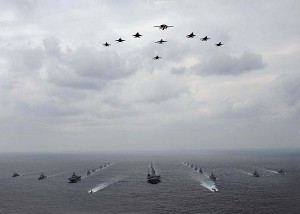 Frank Hoffman has an article in Armed Forces Journal titled Striking a Balance, where he articulates the various lines in the sand of emerging theories for military threats and force structure in the QDR debate. Expanding upon the simplistic “conservatives” and “crusaders” model previously articulated by Andrew Bacevich in his Atlantic Monthly article from last year titled The Petraeus Doctrine, Hoffman describes four schools of thought and breaks them down in detail. The four schools of thought, according to Frank Hoffman, are:
Frank Hoffman has an article in Armed Forces Journal titled Striking a Balance, where he articulates the various lines in the sand of emerging theories for military threats and force structure in the QDR debate. Expanding upon the simplistic “conservatives” and “crusaders” model previously articulated by Andrew Bacevich in his Atlantic Monthly article from last year titled The Petraeus Doctrine, Hoffman describes four schools of thought and breaks them down in detail. The four schools of thought, according to Frank Hoffman, are:
- Counterinsurgents, who emphasize the high likelihood and rising salience of irregular adversaries.
- Traditionalists, who place their focus on states presenting conventional threats.
- Utility Infielders, who balance risk by striving to create forces agile enough to cover the full spectrum of conflict.
- Division of Labor, who balance risk differently by specializing forces to cover different missions to enhance readiness.
This article is great, because it does pro and con of each school and offers opinions, but intentionally does not offer a recommendation. In more detail, I quote Hoffman to better articulate what each school stands for:
Counterinsurgents
This school argues for a transformation based on today’s fights. The advocates here believe that Iraq and Afghanistan represent far more than a passing blip in the evolution of conflict. They contend that massed formations comprised of traditional arms and large-scale conflict between conventional powers is not a realistic planning scenario. They contend that the most likely challenges and greatest risks are posed by failing states, ungoverned territories, transnational threats and radical versions of Islam.Traditionalists
The Traditionalists sit at the opposing end of the spectrum of conflict. This school seeks to re-establish the traditional focus of the armed forces on “fighting and winning the nation’s wars.” Its members focus on major, high-intensity interstate wars. They advocate against reorienting forces, especially ground forces, away from their traditional emphasis on large-scale, industrial-age warfare against states or an alliance of states.Utility Infielders
The third and most prevalent school, at least among American ground force commanders, is the Utility Infielder school. This school recognizes the need to deal with strictly conventional tasks and irregular threats. It seeks to cover the entire spectrum of conflict and avoid the risk of being optimized at either extreme. Instead, it seeks to spreads this risk across the range of military operations by investing in quality forces, educating its officers for agility in complex problems, and creating tough but flexible training programs.Division Of Labor
There are a number of analysts that reject the fundamental premise of the Utility Infielders school. This alternative school argues that irregular and conventional warfare are markedly different modes of conflict that require distinctive forces with different training, equipment and force designs. This camp places a great emphasis on preventing conflict, on stability operations and on investing in indirect forms of security forces with a greater degree of specialization for security cooperation tasks and war fighting. Because this school specifically divides and specializes roles and missions between the services, it can be labeled the “Division of Labor” option.
The article concludes with Hoffman claiming “the current bifurcation of the spectrum of conflict between irregular and conventional wars is a false choice and intellectually blinds us to a number of crucial issues.” I don’t disagree with that conclusion, but in a period of debate that accounts for the wars we are in, and the wars of history that suggest the wars we may find ourselves in, I think the debate is very healthy.
After reading the schools of thought, I began wondering how these schools would break down among those looking at force structure from purely a Navy point of view. Who are the counterinsurgents in the Navy today? Who are the traditionalists? Are the Utility Infielders that are prevalent among ground force commanders also prevalent among naval commanders? What is the division of labor crowd look like in the Navy.
I’m going to take a shot at matching a category into Navy terms, feel free to suggest where I am going wrong.
Counterinsurgents
Today’s counterinsurgents in the Navy debate are the “go small” and/or “go underwater” crowd. This school argues for a transformation based around numbers, with a premium on numerous lower cost platforms. Aircraft carriers are too big, cruisers are too big, destroyers are too big, and even the LCS is too big. This school tends to argue that surface ships in large quantities make up for lack of quality, and submarines will control the sea during future wars. Stealth, precision, and mobility represent constants of naval warfare. Well known Navy blogger Mike Burleson represents this school over at New Wars.
Traditionalists
Today’s traditionalists believe aircraft carriers, major surface combatants, and submarines represent the most effective way to win war, and war at sea will primarily be conducted vs other state naval powers. Its members focus on major, high-intensity interstate wars and emphasizes superiority of the electronic battlefield spectrum. They advocate against reorienting forces, especially surface combatants, away from their traditional emphasis on large-scale, industrial-age multipurpose warships optimized to fight against states or an alliance of states. Most of Navy leadership today attends the traditionalist school.
Utility Infielders
Utility Infielders recognize the need to deal with strictly conventional tasks and irregular threats. It seeks to cover the entire spectrum of conflict and avoid the risk of being optimized at either extreme, defining the extremes as blue water and littoral waters. This school is open to reducing carrier fleets, open to building conventional submarines, open to building more smaller ships while sacrificing larger ships, and tends to emphasize the utility of amphibious ships and logistics ships as a solution to a wide range of operational requirements. Commander Henry J. Hendrix’s Proceedings article earlier this year, Buy Ford, Not Ferrari, represents this school well.
Division of Labor
There are a number of analysts that reject the fundamental premise of the Utility Infielders school. This alternative school argues that irregular and conventional warfare are markedly different modes of conflict that require distinctive forces with different training, equipment and force designs. This camp places a great emphasis on preventing conflict, on stability operations and on investing in indirect forms of security forces with a greater degree of specialization for security cooperation tasks and war fighting. One will find a Global Fleet Station specific ship and numerous varieties of single purpose platforms in the fleet designs of this school. An example of the Division of Labor school is Wayne Hughes’ New Navy Fighting Machine, although it should be noted that each Division of Labor example will be different.
When laid out this way I think Hoffmans comment regarding how “the current bifurcation of the spectrum of conflict between irregular and conventional wars is a false choice and intellectually blinds us to a number of crucial issues” becomes readily apparent as a warning. When I think of naval forces, I see several false choices, like Small Ships vs Big Ships, or Blue Water vs Brown and Green Water to name a few examples.
Despite the apparent public friction and debate raging among the ground forces, who argue based on actual war experience, the Navy is at a disadvantage in such a debate. There have been so few sea battles fought in the last half century that it is difficult to claim with any certainty that any one school has the advantage over others. That raises important issues, for example, not only must QDR analysts determine the positive and negative influences of untested technologies, but must define what naval warfare will even look like in the 21st century. The second part is a much greater challenge than the first.

